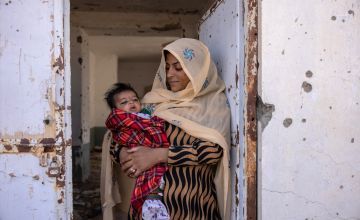
Knowledge Hub
Afghanistan: what is the situation on the ground right now?

Concern Worldwide’s Head of Emergency Operations Ros O’Sullivan has just returned from five weeks in Afghanistan. We spoke to him about what the situation is really like on the ground in a country where there is an escalating humanitarian crisis.
An unforgiving climate
“At the best of times, Afghanistan is an incredibly harsh place for people to live and to make a living, and a big part of that is the weather extremes,” Ros told us.
The coming winter months in Afghanistan is one of the biggest challenges facing the country right now.
Average temperatures across Afghanistan range from -10⁰C in the winter and above 40⁰C in the summer. The country is full of mountain ranges, with much of the population living in their foothills or in the valleys below them, and winters there are extremely harsh.

However, cold temperatures alone are not the issue. A harsh climate is just one of a compounding number of problems that makes life so difficult for people living in Afghanistan.
People have come out of decades of war, the economy is on its knees, public service salaries haven’t been paid for six months, and on top of that you’ve now got winter.
Consequently, winterisation is a big focus for Concern. The main areas of response to help people prepare for and survive winter are food and warmth. Specifics include heating, food, clothes, blankets and emergency shelter materials. There is also an emphasis on repairing damaged houses. Most dwellings and compounds in rural Afghanistan are mud structures - very few people live in brick houses - meaning they are easily damaged by both weather and conflict conditions.
Severe hunger: disrupted supply routes, current restrictions on aid and climate change
Years of conflict, poverty and disruption caused by the Covid-19 pandemic were already taking their toll on the people of Afghanistan. The economic and social impact of the recent conflict, coupled with the worst drought in 27 years, have tipped the country over the edge. Right now, more than half the population do not have enough to eat and 8.7 million people (almost a quarter of the population) are on the brink of famine, suffering from very high rates of malnutrition. Even in the areas of the country that have good harvest and food available, people have no money to buy it.
With Afghanistan’s economy in tatters, the country was always heavily reliant on aid, even prior to last August and the change of government. Some aid that was going directly to the previous government to Afghanistan ended abruptly following theTaliban takeover and as a result, many families are struggling to survive. More than ever, now we are seeing huge levels of urban poverty in the provincial areas as many civil servants and former government employees have lost their job, or at least their salaries. Many teachers and medical staff remain working with no salary or resources.

Generally, a large proportion of incomes in Afghanistan are made up of subsistence farming, a little trading and family remittances from overseas. Remittance is significant and now more than ever, people are heavily dependent on it.
According to Ros, many families have two or three male members working in Turkey, Pakistan or Iran, sending home a bit of money here and there. But what they are sending home is often not enough to cover basic needs As a result, a lot of the humanitarian work now is shifting to cash programming “to support the markets that do exist and to support the failing economy where it is still functioning,” according to Ros.
Afghanistan is also currently experiencing a severe drought that is affecting more than 80% of its population. Because of this, farmers told Ros that their expected yields – even those from irrigated land – are down by upwards of 50%.
“It’s not just about lack of rainfall,” said Ros, “it is also about the fact that the irrigated land is not producing the yields it would have been expected to produce in recent years.” Climate change is really affecting food production and low yield means less food, putting even more lives at risk.
Opportunities for change going forward
However, it is not all doom and gloom; there is also hope. Ros explained:
“With the Taliban now firmly in control of the whole country, it means there are now no frontlines. This means there is now greater access to rural areas, particularly areas that would not have been accessible at any time in the last decade or two due to insecurity.”
The humanitarian community can now get to areas that were inaccessible before, and this is vital. Many of these areas have seen absolutely no development support in the last two decades.
Concern has been working in Afghanistan since 1998 in some of the most remote areas of Northeast of the country. During that time, Concern has established strong relationship with local communities who help us ensure that aid gets to where it is needed most. However, now we hope we can reach more places and more people than ever before.
Help families survive this devastating crisis
Other ways to help
Donate now
Give a one-off, or a monthly, donation today.
Join an event
From mountain trekking to marathon running, join us for one of our many exciting outdoor events!
Buy a gift
With an extensive range of alternative gifts, we have something to suit everybody.
Leave a gift in your will
Leave the world a better place with a life-changing legacy.
Become a corporate supporter
We partner with a range of organisations that share our passion and the results have been fantastic.
Create your own fundraising event
Raise money for Concern by organising your own charity fundraising event.





